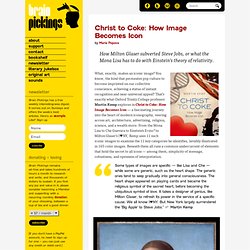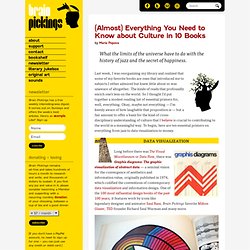

Christ to Coke: How Image Becomes Icon. By Maria Popova How Milton Glaser subverted Steve Jobs, or what the Mona Lisa has to do with Einstein’s theory of relativity.

What, exactly, makes an iconic image? You know, the kind that permeates pop culture to become imprinted on our collective conscience, achieving a status of instant recognition and near-universal appeal? That’s exactly what Oxford Trinity College professor Martin Kemp explores in Christ to Coke: How Image Becomes Icon — a fascinating journey into the heart of modern iconography, veering across art, architecture, advertising, religion, science, and a wealth more.
From the Mona Lisa to Che Guevara to Einstein’s E=mc² to Milton Glaser’s I♥NY, Kemp uses 11 such iconic images to examine the 11 key categories he identifies, lavishly illustrated in 165 color images. Some types of images are specific — like Lisa and Che — while some are generic, such as the heart shape. Mona Lisa, digitally restored. Enrique Avila Gonzalez, Che Guevara. Share on Tumblr. 5 Essential Books and Talks on the Psychology of Choice. By Maria Popova The psychology of spaghetti sauce and why too many jams make you lose your appetite.

Why are you reading this? How did you decide to click the link, load the page and stay? How do we decide to do anything at all and, out of the myriad choices we face each day, what makes one option more preferable over another? This is one of the most fundamental questions of the social sciences, from consumer psychology to economic theory to behavioral science. Today, at the risk of meta-irony, we look at not one but five fantastic books and talks that explore the subject. Among other things, Jonah Lehrer writes the excellent Frontal Cortex blog for Wired, one of our favorites. Amazon has a nice Q&A with Lehrer on the book page, in which he addresses everything from neuroscience to how he handles the cereal aisle. Barry Schwartz studies the relationship between economics and psychology. The book’s sequel, The Upside of Irrationality, is also a fascinating read and highly recommended.
(Almost) Everything You Need to Know about Culture in 10 Books. By Maria Popova What the limits of the universe have to do with the history of jazz and the secret of happiness.

Last week, I was reorganizing my library and realized that some of my favorite books are ones that introduced me to subjects I either admired but knew little about or was unaware of altogether. The kinds of reads that profoundly enrich one’s lens on the world. So I thought I’d put together a modest reading list of essential primers for, well, everything. Okay, maybe not everything — I’m keenly aware of how laughable that proposition is — but a fair amount to offer a basis for the kind of cross-disciplinary understanding of culture that I believe is crucial to contributing to the world in a meaningful way.
Images courtesy of insect54 The idea of a ragtime ballet or opera must have seemed an oxymoron to those on both sides of the great racial divide that characterized turn-of-the-century American society. Popular films are a special kind of drama. Share on Tumblr.